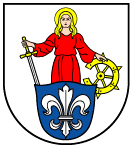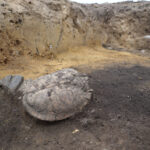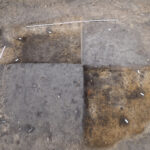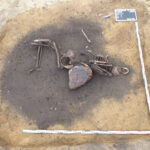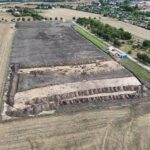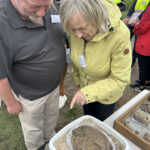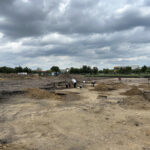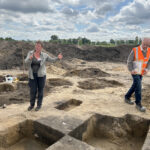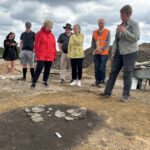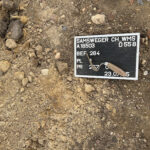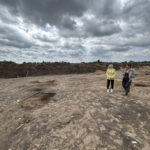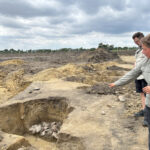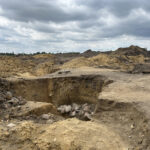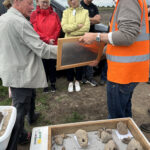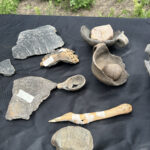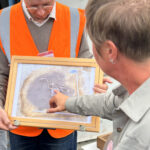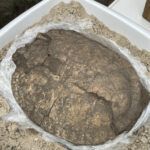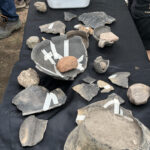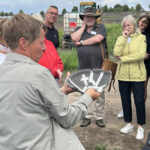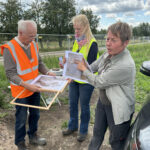Archaeologists present initial excavation results: Wolmirstedt already offered the best location for settlements 3,000 years ago
Since the beginning of June 2025, archaeological investigations have been taking place on the site on Samsweger Straße, where the city of Wolmirstedt’s new sports stadium is to be built. The excavation team led by excavation manager Juliane Huthmann, who will be working on the site until October, have already made some interesting discoveries. The State Office for the Preservation of Monuments and Archaeology of Saxony-Anhalt has now presented the initial results. In addition to representatives of the press, Wolmirstedt’s mayor Marlies Cassuhn and Tobias Maasberg, the employee responsible for the stadium construction, were shown and explained the findings so far. Wolmirstedt’s museum director Mary-Anette Pilz also looked over the archaeologists’ shoulders at the event.
The State Office for the Preservation of Monuments and Archaeology explains the findings in a press release as follows:
“The archaeological work on an area of around 21,000 square meters on the western outskirts of Wolmirstedt is being carried out in parallel with the land levelling required for the construction of the sports facility. The results documented so far prove that there was an extensive settlement here in the late Bronze Age. The numerous finds and features indicate that even 3,000 years ago, the favorable location of the site directly on the Ohre and near its former mouth into the Elbe was appreciated. During the late Bronze Age (around 1,300 to 750 BC), the conveniently located region on the lower Ohre was characterized by the meeting of two large cultural groups. These were the Nordic circle of the Bronze Age and the Lusatian culture, whose influences are manifested in local groups such as the so-called Elb-Havel group and the Saalemündung group.
A settlement from the late Bronze Age
On the slightly ascending northern edge of the Ohreniederung, 322 archaeological features have already been documented and over a thousand finds recovered from the 5,000 square meter area investigated so far. The findings are mainly settlement pits and waste pits. In some cases, round food storage pits, originally lined with wickerwork, typical of the period were used secondarily for waste disposal. Three pits can be identified as ovens on the basis of their brick-lined side walls and fragments of burnt clay and charcoal in the backfill. In two of the kiln pits, burnt clay fragments with impressions of logs allow conclusions to be drawn about kiln superstructures or kiln covers. The third kiln pit revealed a unique feature: at the edge of the pit, in addition to a
Ceramic sherd concentration of the shell of a pond turtle uncovered; laboratory tests will show whether or how the animal was prepared. Several larger excavations can be interpreted as material extraction pits for clay extraction.
Some of the settlement’s buildings were identified by means of post pits. Based on the structural posts, a larger residential building as well as smaller farm buildings and storage buildings can be identified. The two-aisled main building, which was not fully recorded, was 4 meters wide and more than 6 meters long. The six-post storage buildings measured around 2 by 3 meters. A recessed building measuring 4 by 3.3 meters should be highlighted. A row of pyramid-shaped loom weights indicates that it was a weaving house. A standing loom was used to produce lengths of fabric about 60 centimetres wide.
The extensive finds from the Wolmirstedt excavation were dominated by pottery: rough-walled storage pots and cooking pots typical of the Late Bronze Age, as well as some decorated jugs and cups. In addition, bronze rings and awls made of bronze and bone were occasionally recovered. However, most of the animal bones found – including those of cattle, pigs and sheep/goats – were food remains.
A mysterious burial
The discovery of a human skeleton points beyond pure settlement activity. While the dead in the Late Bronze Age were usually cremated on pyres and buried in urn cemeteries outside settlements, there are occasional inhumations within settlement areas. This was also the case in Wolmirstedt: a corpse was found in a settlement pit in a squatting position with its head twisted. The deceased was an adult, sturdy man who was about 1.7 meters tall. No trauma or signs of deformity were found on the bones at the first sighting. The motivation for such ‘irregular’ burials is unclear. Are they evidence of ritual acts? Were there multi-stage burial processes? Do they reflect social differentiation?
Outlook
The excavations in Wolmirstedt provide a multi-layered insight into the world of the late Bronze Age. Once the site work has been completed and the excavation documentation and finds have been evaluated, a complex picture of a settlement or a group of farmsteads in a cultural border region will emerge. The excavations by the eight-person team from the Saxony-Anhalt State Office for Monument Preservation and Archaeology will continue until October 15, 2025.”
The construction of the stadium represents the largest investment project in the town of Wolmirstedt since 1990. The symbolic ground-breaking ceremony, which marked the start of the project for the public, took place on May 22, 2025. In the background, however, preparations had already been underway for more than five years. In 2023, for example, the more concrete urban land-use planning, design planning and building inspections were carried out, funding applications were submitted and the first tenders were issued.
In 2024, the building permit process continued, construction work was awarded and archaeological investigations were carried out. After the ground-breaking ceremony in May 2025, archaeological fieldwork began in June. The first results of these excavations will be presented to the public by the Saxony-Anhalt State Office for the Preservation of Monuments and Archaeology on July 23.
The archaeological investigations are scheduled to continue until October 2025, with land leveling and development work running in parallel. The actual construction of the stadium will take place in 2026 and 2027, when large pitches with natural grass and artificial turf, a type B pitch, a functional building, a grandstand, a pitch and parking spaces will be built and outdoor facilities and ancillary areas will be prepared. The city of Wolmirstedt already has a date in mind for the stadium’s inauguration, which is scheduled for September 4, 2027.
As things stand, the project will cost around 10.5 million euros. Around 4.3 million euros of this will be financed by subsidies from the state of Saxony-Anhalt. In future, the sports clubs “Ohrekicker” and “SV Kali” will train in the new stadium near Samsweger Straße, and the outdoor sports facility will also be used by schools and day-care centers. Once the new stadium has been built, the old stadium in Küchenhorn will be dismantled and the area renaturalized to restore its natural function and absorb water from the Ohre in the event of flooding.
